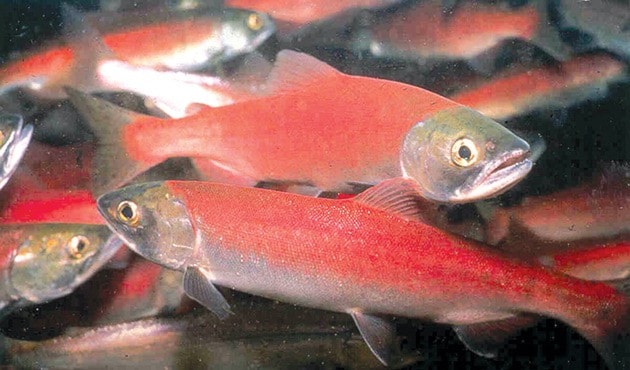Five to seven million kokanee eggs will be introduced into the Meadow Creek spawning channel this year as part of attempts to rescue the Kootenay Lake trout fishery.
The provincial government outlined its plan at a public meeting attended by about 90 people in Balfour on Thursday.
The plan, developed by 25 scientists, mostly from the provincial government, aims to increase the kokanee population while controlling the populations of the kokanee’s main predators, bull trout and Gerrard rainbow trout, both of which form the basis of the Kootenay Lake sports fishery.
This follows the recent collapse of kokanee stocks in Kootenay Lake over the past two years.
The recovery plan, set up to rebuild the kokanee population over the next five years, has three other components:
• continue the current fishery closures;
• continue the nutrient restoration program which has run since the 1990s to compensate for nutrients lost through dam construction;
• monitor all of the above more closely with new methods and technologies.
“The kokanee are a keystone species,” the plan states, “important for predators and the maintenance and diversity of other aquatic and terrestrial species.”
Jeff Burrows of the Ministry of Forests, Lands and Natural Resource Operations says the collapse of the kokanee affects not only its predators but “grizzlies, black bears, mallard ducks, dippers eating the eggs, osprey and bald eagles, and so on. It is a long list.”
The collapse of the kokanee, and the measures outlined in the plan, apply to the main lake only and not to the West Arm of Kootenay Lake, which has not collapsed but is always of concern
Current fishing restrictions in the main lake are: a moratorium on kokanee; four rainbow per day with only one over 50 cm; and one bull trout per day. In the West Arm: two rainbow per day, one bull trout per day, zero kokanee in the Upper West Arm, and in the lower West Arm five kokanee per day on weekends.
The action plan report is attached below.
Burrows said enhanced monitoring is a key part of the action plan.
“We have identified triggers, where we would turn these actions [listed above] on or off. For example, if kokanee spawner numbers in the North Arm get to 140,000, it will not be necessary to supplement [by introducing eggs to the spawning channel], and they can recover on their own.”
Burrows says the central issue is finding the delicate balance in predator-prey numbers so bull trout and Gerrard rainbow can thrive enough to be available as sports fish but not so much that they overwhelm their main source of food, the kokanee.
“There is a risk we are just extending the issue by feeding too many predators and they will have to adjust,” Burrows says. “This is why we devised an enhanced monitoring program and the intention is to be very flexible and change the actions if there’s an indication it’s working incorrectly. So we will react to every signal that comes in.”
Burrows said the ministry conducted genetic research that identified three strains of kokanee from elsewhere that are genetically similar to those in Kootenay Lake, to be introduced to the Meadow Creek channel.
He said the province and the Freshwater Fisheries Society of BC (fishing licence revenues) have provided additional funding to carry out the program.
The Kootenay Lake fishery, built mostly around bull trout and Gerrard rainbow trout, is visited by 20,000 to 40,000 anglers per year and is estimated to be worth $5 million to $10 million annually to the local economy.
Burrows indicated the kokanee recovery could take a few years, but Harvey Andrusak, the consultant who authored the plan, thinks that’s optimistic.
“I think what was missing from the meeting, and the only thing that matters from a public point of view,” he told the Star, “is that there was no clear indication how long the recovery is going to take. The ministry gave a rather positive outlook on recovery. I don’t agree with it. I think it will be a lot slower than imagined. We are talking about well over a decade before we’re back to what we used to know as a very productive fishery.”
Andrusak is a retired regional fisheries biologist and retired director of fisheries for the province as well as a member of the BC Wildlife Federation.
“There are caveats in the report,” he said, “because nobody knows with certainty whether there is sufficient decrease in predation to allow the kokanee to rebuild.”
Eileen Delehanty Pearkes, a local author and historian with a particular interest in the Columbia River system and the dams, attended the meeting.
“It was vastly more positive than the one last June,” she said. “It demonstrated the government is putting financial and staff resources into this problem. That is a big step forward. They are taking it seriously.”
She said there was still some feeling of mistrust at the meeting — doubts the government will do the right thing.
“People who have fished all their adult lives on that lake are entitled to their mistrust because they haven’t yet seen the situation reverse itself,” she said.
